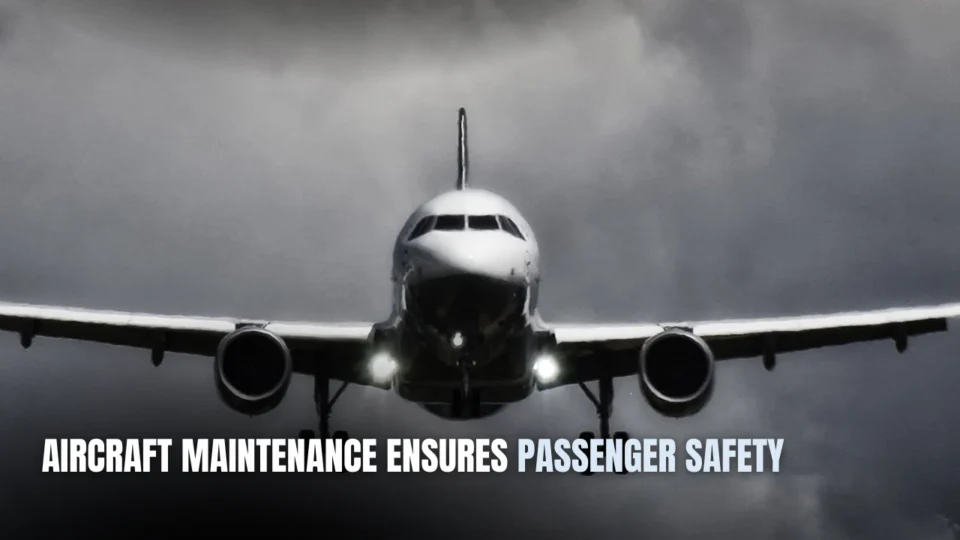You might not realize that before each flight occurs, there is a significant connection between aircraft maintenance and your safety as a passenger. The maintenance of aircraft does not only entail the mere fixing of things but is an extensive procedure that involves preventive methods in ensuring that the above key areas among others are maintainedto minimize untimely failures.
1. Systematic Pre‑Flight Inspections
Every aircraft only after undergo systematic preflight inspections. You assist the technician in observing visible damage such as cracks or loose parts. They check the fluid levels and security to detect any additional fluid or leakage that might cause a threat.
An inspection is carried out on the movement of the control surfaces to ensure the crew can manipulate them effectively. Vitals such as lights and pitot tubes are also checked so as to make the pilots see and interpret the speed of the plane. All the information so obtained is then entered in a detailed record that will make sure that during the next examination, no difficulty is missed.
2. Engine Performance and Reliability Checks
Well trained technicians perform routine tasks of measuring engine performance and reliability and take time on the most important aspects like oil pressure and temperatures to determine whether the engines are in good shape. Fuel systems are inspected to foster a smooth flow of fuel through filters, and this is done to ascertain smooth, efficient, and continuous running of the engine.
They perform compressor stall tests to analyze airflow and determine that the engine produces steady power. The turbine blades are inspected carefully for wear, as they bear the pressure of high-speed rotation. They also schedule borescope inspections to look inside the engine and catch any early abnormalities. Through these daily checks, the engines have both reliability, bringing additional safety in every flight.
3. Structural Integrity and Corrosion Control
In the field of aviation, structural integrity and corrosion control are paramount in maintenance practices that pay equal attention to routine internal and external inspection. Workers examine the fuselage and wing joints very closely to ensure that there are no cracks. There is a special emphasis on paint cracking and corrosion, as these are the initial signs of greater risks.
They take skin thickness measurements to ensure that using an airplane does not compromise its safety. The corrosion inhibitor is applied in vulnerable regions to prevent rust. They always replace worn fasteners and seals, ensuring that all aircraft components are tightly sealed.
4. Ground Support Help
Maintenance of ground support equipment is highly influential in improving the safety of the aircraft in their ground operations. Hydraulic jacks and lifts are also regularly maintained so that they can be in their right working state when performing the lifting and repairs of the aircraft. The tow bars are examined thoroughly each time they are used, making them safe for the aircraft transfer.
The Brackett tow bars are particularly known for their sturdiness and reliability, ideal for the safe movement of various aircraft types. In addition, the ground power unit filters are cleaning or changing to ensure the loading of reliable electricity without interruptions. The technicians adjust the calibrations of the cable tensioners to provide a precise fit and a secure attachment of the patches and supports, thus maintaining total ground safety readiness.
5. Emergency and Safety System Readiness
Everything to do with safety and emergency systems calls for a daily team of maintenance technicians to ensure that emergency and safety systems are operational. They check the fire detection systems and extinguishers, which prevents small fires from turning into disasters. The emergency slide equipment is carefully verified for instant deployment in case of an emergency.
Moreover, life rafts and vests are examined in order not to have problems during an emergency. The oxygen system requires periodic inspection to ascertain that there is sufficient pressure in the oxygen system and that passengers can breathe even in smoky conditions in the air. The emergency procedure placards are continuously updated to guarantee that all safety procedures are noticeable in case of an emergency.
Conclusion
The pre-flight inspections, engine performance, structural integrity and corrosion control, ground support equipment and emergency and safety systems are some of the factors that have made major contributions in improving the safety of passengers. It is also by adhering to these routines with so much precision that you make every section of the aircraft safe. With this type of intensive maintenance, the plane remains in a state of preparedness and forecastable safety throughout every flight the plane has to handle and this kind of approach should never be taken lightly by all the passengers who are in the cockpit at the same time.
FAQs
How safe is flying compared to other forms of transportation?
Flying is one of the safest modes of transportation. Statistically, commercial air travel has a significantly lower accident rate compared to cars, trains, and even buses. Airlines follow strict safety regulations enforced by aviation authorities worldwide.
What should I do in case of an emergency during a flight?
In an emergency, follow the instructions of the flight crew immediately. Listen carefully to the safety briefing at the beginning of the flight, know where the nearest exits are, and review the safety card in your seat pocket. Stay calm and assist others if you’re able.
How are airplanes maintained to ensure safety?
Airplanes undergo regular, rigorous maintenance checks that are mandated by aviation authorities. These include daily inspections, routine servicing, and scheduled deep maintenance checks (like A, B, C, and D checks) to ensure all systems are functioning properly.
Can turbulence cause a plane to crash?
Turbulence is common and rarely dangerous. Modern aircraft are built to withstand extreme conditions, including severe turbulence. While it can be uncomfortable, turbulence almost never causes accidents. Keeping your seatbelt fastened when seated helps prevent injury.

